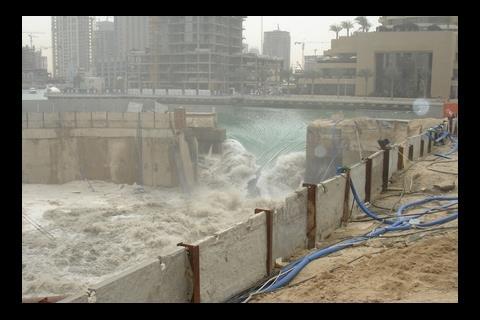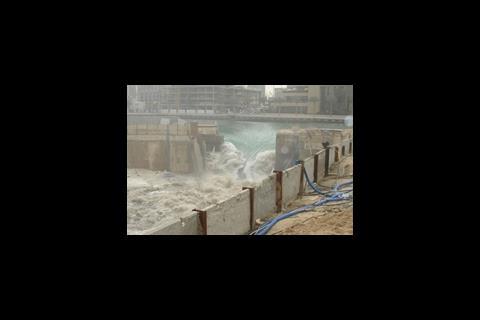For contractors active overseas, meeting their duty of care to workers requires a much wider assessment of risk - including natural disasters and insurgent attacks
In 2007, amid protests and a general strike against the leadership of Guinea's president, Lansana Conté, violent demonstrators killed more than 100 people and a state of martial law was announced. Acting swiftly, contractors on a remote mining construction site in Sangaredi managed to successfully extract some 60 workers.
Construction companies overseas must ensure best practice, such as providing general site safety. However, contractors must ask themselves: Does our risk strategy provide the means to cater for wider issues, such as environmental disasters or conflict outbreaks?
Contractors may not consider this as a likely scenario at their existing sites, or one they may encounter when branching out into international markets. Regardless of scale or complexity, all health and security issues must be considered. This can include anything from ensuring that all equipment meets the required safety standards to arranging armed site security in high-risk regions. Overlooking risks of any kind can place workers and civilians in danger and lead to swift and often damaging reprisal.
Companies are bound, legally and morally, to ensure minimum standards of health and safety protection to employees. This presents a problem to contractors that cast their nets far and wide. How can management ensure that each site is offered the same degree of protection, when the risks in different regions are so diverse?
Ground rules on risk assessment
The answer, unfortunately, is not a simple one. However, there are several ground rules contractors must consider. While potential risks to the well-being of workers range from low-level insurgency to natural disasters and serious medical issues, there are a set of procedures that contractors would do well to follow.
Contracting organisations must first outline their minimum health and security standards clearly, in written policy. On large-scale infrastructure projects, it is essential for this to be communicated to all relevant parties. Such ventures may involve many consultants and subcontractors, and it is crucial that they all receive the relevant documentation and briefing when coming on board.
Overlooking risks of any kind can place workers and civilians in danger and lead to swift and often damaging reprisal
Employers should start this process by implementing a duty of care programme at the recruitment stage. This will allow contractors to pre-screen candidates to ensure that they hire the right type of person, in both personal and technical terms.
Contractors must also provide workers with appropriate pre-deployment packages tailored to the country they will be working in. These should include cultural briefings, security awareness training and occupational health guidance. This must continue throughout the course of employment, with regular refresher training and additional briefing where necessary.
Before sending workers to an overseas site, the venture must be thoroughly risk assessed. Although assessments are required to cover much ground, they do not have to be overly complex. Subsequent strategies for risk or crisis management will end up achieving little if there are inaccuracies or shortcomings at this early stage. Should a worker become injured (or worse) on site, the contractor will be subjected to finger pointing and claims of negligence, unless it can prove it did everything possible to fulfil its duty of care.
To ensure that the employer fulfils this duty, risk assessments must not be conducted solely from the comfort of the boardroom. They must be planned in collaboration with a qualified or experienced individual based on the ground in the proposed project region. This person must be able to justify later why particular processes have been implemented. They must also be able to give an explanation of why something could have been overlooked, in the event of an inquiry following an accident or security breach.
Consider all eventualities
Management must consider any and all eventualities. It is crucial to take into account security, environmental and medical concerns, including standard health and safety issues. Implementing new policies after a foreign project has started can lead to friction with contractors and increased costs. Companies will find that retrofitting a risk management strategy will prove ineffective. This invariably leads to friction with contractors and increased costs.
Once a contractor is confident that all potential risks have been assessed and a subsequent risk management strategy has been devised, it can proceed with an international project. However, the assessment process is a continuing one and risk strategies must be adaptive to changes in the local health or security climate.
Should a worker become injured (or worse) on site, the contractor will be subjected to claims of negligence unless it can prove it did everything possible to fulfil its duty of care
For example, the New People's Army, the armed wing of the Communist Party of the Philippines, attacked an airport construction site in Silay City in 2006. Dozens of guerrilla terrorists destroyed equipment with bombs and disarmed site guards. Nobody was injured in the attack, but this is the kind of scenario that contractors operating in volatile regions must consider.
Bearing in mind the speed at which such a situation can escalate, there is no room for a lacklustre security policy. Similarly, environmental hazards such as floods, hurricanes or earthquakes can occur unexpectedly. Businesses must have the means to ensure that workers are evacuated effectively. This is best achieved by establishing a single point of contact - one phone number that they can call to be put through to the relevant emergency services.
While sound evacuation strategies are critical in relocating workers during a crisis, contractors must look beyond this. What happens once they return to a site? When working with local subcontractors, it is possible that their workers will not have been evacuated during an emergency. Companies returning to communities or business partners that were left behind will always prove problematic. Incorporating corporate social responsibility (CSR) programmes into a risk management strategy can help reduce any subsequent reputational damage.
CSR is vital to reducing the economic, social and environmental impact of overseas business operations. It plays a key role in how the local community perceives a company. This can be established through several methods. For example, contractors may wish to implement outreach programmes, offering healthcare or other such provision to residents in local areas. Maintaining good community relations can prove to be a test of resilience, particularly, in countries where this might go some way to reducing the possibility of a terrorist attack.
With so many factors to consider, contractors could be forgiven for feeling a little lost when attempting to draw up a risk management strategy. From ensuring that workers with allergies can receive the correct medicine in Venezuela, to briefing employees on the strict customary beliefs in the Middle East, everything must be considered and nothing must be overlooked.
Mike Penrose is a regional director for International SOS, the world's largest medical assistance company and manager of international medical, healthcare, security risks and outsourced customer care.
Postscript
Mike Penrose is a regional director for International SOS, the world's largest medical assistance company and manager of international medical, healthcare, security risks and outsourced customer care.

























No comments yet